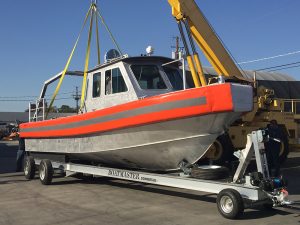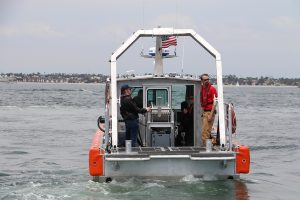Significant progress has been made in the development and deployment of the two Rigid Hull Inflatable Boats (RHIB) that are designed for service at NSF's Palmer Station.
Since the most recent update on this site, both hulls were shipped from Alabama to the shipyard in California for the final phases of construction. This included resolving several engineering challenges in order to ensure the boats are fully functional and will be up-to-specification upon delivery to Palmer.
Sea trials were carried out on the first hull in the waters off Long Beach, California to ensure all systems meet the specifications required to operate in the demanding polar environment and to carry out a variety of scientific deployments.
The second hull is currently in the California builder's yard with delivery to Palmer Station planned for mid-2017.
During the sea trials, tests were performed to evaluate:
- Bottom coring
- CTD deployment
- Net tows
- Use of a J-frame for deployment and recovery of equipment
- Ease of moving the J-frame from starboard to port
- A-Frame and research winch performance for deployment and recovery of equipment over the stern
Tests were also conducted on all redundant systems, including hydraulics, fuel tanks and fuel delivery. Our sea trials focused on reliability, stability, speed and maneuverability of the vessel including the Volvo IPS Joystick docking system, which will help the vessel maneuver in tight quarters.
The first RHIB has been delivered to Port Hueneme, Calif. and prepared for its 7,000-mile journey to Punta Arenas, Chile. From there, it will be loaded on the Laurence M. Gould and delivered to Palmer early in 2017. Once at Palmer, the first RHIB will be inspected, configured, outfitted and given additional trials before going into service in the 2017-2018 field season.






